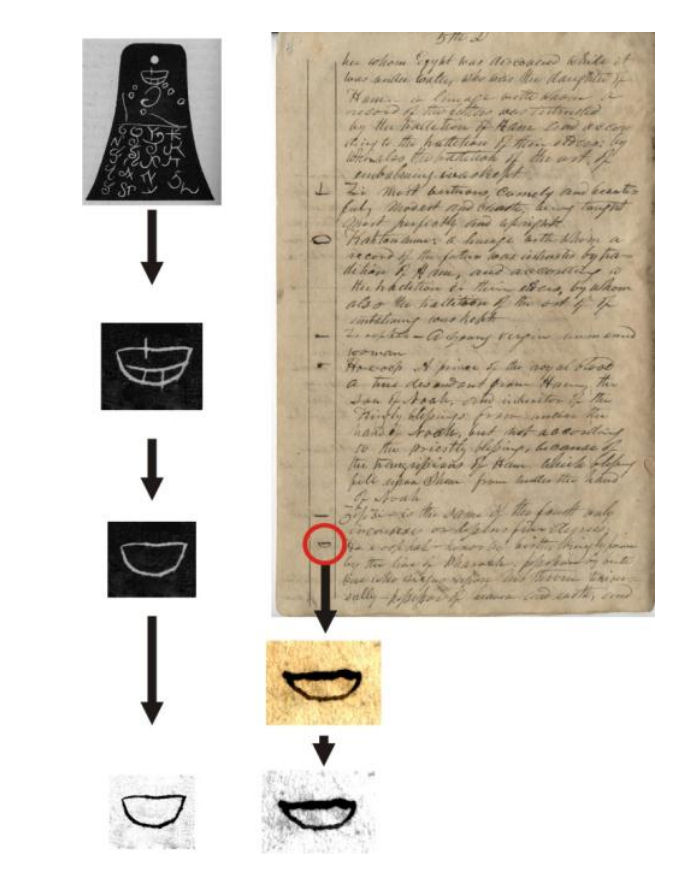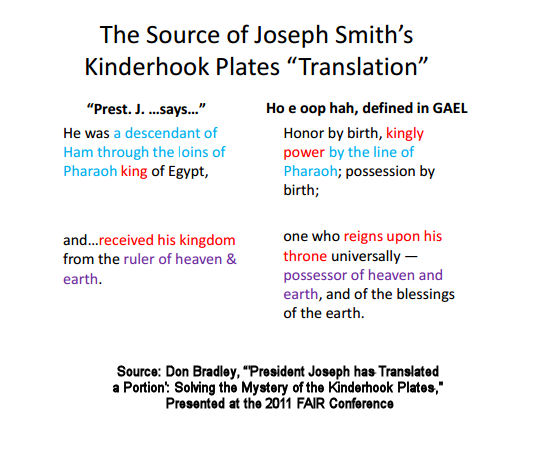- REDIRECT Template:Headers and footers:Main Page
Contents
- 1 Response to MormonThink page "The Kinderhook Plates"
- 1.1
- 1.2 FAIRMORMON'S VIEW OF THE CRITICS' CONCLUSIONS
- 1.3 FAIRMORMON'S RESPONSE AND SUPPORTING DATA
- 1.4 On their old website, MormonThink claims...
Also, there is no part of the Book of Abraham or the Grammar & alphabet of the Egyptian Language by Joseph Smith that talks about a descendant of Ham, through the loins of Pharaoh, king of Egypt, and that he received his kingdom from the Ruler of heaven and earth. Find that phrase in the BOA or in the GAEL.
- 1.5 On their old website, MormonThink claims...
Since the plates have been proven to have been manufactured in the 1800s as a hoax, how could the prophet Joseph Smith have translated a portion of these plates and say that they give an account of a descendant of Ham through the loins of Pharaoh, King of Egypt?
- 1.6 On their old website, MormonThink claims...
[T]he church backed off on its claims that the Kinderhook Plates were real. The LDS historians quickly changed their story and stopped defending that the plates and Joseph's translation of them were true. Now the LDS apologists say it was all a hoax, and Joseph never fell for it, and someone other than Joseph must have said that the plates tell a story of a descendant of Ham.
- 1.7 On their old website, MormonThink claims...
Critic's Point: Even if you don't believe that Joseph was fooled by the Kinderhook Plates in 1843, the LDS Church itself was fooled for the next one hundred and thirty years. The Kimball article [Ensign, Aug. 1981, 66-74] mentioned the Church's response each time the issue of the plates came up, but it failed to recognize that each response up to 1981 was the same, that the plates were genuine.
- 1.8 On their old website, MormonThink claims...
Critic responds to the Ensign article.
Why wasn't this ever the Church's position before scientists proved the plates were fake? If the Kinderhook Plates were really just a hoax, then why didn't the Church ever say that in the first 130 years since the KP were unearthed? It's clear from the evidence above that the Church leaders believed the KP were real and that Joseph translated a portion of them. Why did it take finding evidence that proved the KP were fake to have the Church change their mind on whether or not Joseph tried to translate them? The Church only seems to change their beliefs (like the limited geography theory of the Book of Mormon, Book of Abraham, location of Hill Cumorah, American Indians are the principle ancestors of the Lamanites, etc.) when contradictory evidence disproves their recorded history. This seems inconsistent with a church run by modern-day prophets with modern revelation.
- 1.9 On their old website, MormonThink claims...
Critic response to true believer.
Who else would have been able to make these grand claims? Why would a scribe think this Indian was a descendant of Ham through the loins of Pharaoh king of Egypt, and that he received his kingdom from the ruler of heaven & earth? Why not a descendant of Noah or Abraham? This seems way too unusual and too specific to be made by anyone other than the Prophet Joseph Smith. Also, Joseph's scribe William Clayton, was a trusted, official scribe for the church and was noted for being a stickler for details and accuracy and not in the habit of making stuff up and attributing it to Joseph.
Response to MormonThink page "The Kinderhook Plates"
FAIRMORMON'S VIEW OF THE CRITICS' CONCLUSIONS
The positions that the MormonThink article "The Kinderhook Plates" appears to take are the following:
- MormonThink spends a lot of effort to illustrate the historical fact that the Church believed the Kinderhook plates to be genuine for many years before they were proven to be a hoax. The editors then conclude by casting doubt upon Joseph Smith, stating: "If Joseph did misrepresent himself about the Kinderhook Plates, for whatever reason, we wonder what else he may have misrepresented about himself?"
FAIRMORMON'S RESPONSE AND SUPPORTING DATA
On their old website, MormonThink claims...
Also, there is no part of the Book of Abraham or the Grammar & alphabet of the Egyptian Language by Joseph Smith that talks about a descendant of Ham, through the loins of Pharaoh, king of Egypt, and that he received his kingdom from the Ruler of heaven and earth. Find that phrase in the BOA or in the GAEL.
FairMormon commentary
- Historian Don Bradley demonstrated that a character found on the Kinderhook plates matched a character found in the GAEL (Grammar and Alphabet of the Egyptian Language). The explanation for the deconstructed components of that character in the GAEL corroborates the "translation" given by Joseph for the same Kinderhook character.


- Bradley's commentary related to the image above:
Here, then, let’s compare the two: what Clayton says Joseph Smith has translated from the Kinderhook plates, and the definition given for “ho e oop hah” in the GAEL. So in
red there, you’ve got the idea of Kingship, and Joseph’s says, according to Clayton, that the plates say this guy is a King, “received his kingdom”; in the “ho e oop hah” definition we’ve got “kingly power,” “reigns upon his throne,” in each case we are talking about a King. In blue there we’ve got, from the reported translation by Joseph from the Kinderhook plates, “descendant of Ham through the loins of Pharaoh,” in the GAEL from this character we’ve got, “by the line of Pharaoh.” Pharaoh is, of course, in the Book of Abraham described as a descendant of Ham, so if you are a descendant of Pharaoh you are a descendant of Ham, by definition. Then in violet here we’ve got from Joseph’s reported translation of the Kinderhook plates, the phrase “ruler of heaven and earth,” and from this definition for this character in the GAEL, we’ve got “possessor of heaven and earth.” (emphasis added)
Additional information
- Kinderhook Plates—A set of small plates, engraved with characters of ancient appearance, were purported to have been unearthed in Kinderhook, Illinois, in April 1843. The so-called "Kinderhook plates" have been something of an enigma within the Mormon community since they first appeared. While there are faithful LDS who take a number of different positions on the topic of these artifacts, most have concluded that they were fakes. This article summarizes some key information that critics often exclude from their discussion of the Kinderhook plates, and the extent of Joseph Smith's involvement. (Link)
On their old website, MormonThink claims...
Since the plates have been proven to have been manufactured in the 1800s as a hoax, how could the prophet Joseph Smith have translated a portion of these plates and say that they give an account of a descendant of Ham through the loins of Pharaoh, King of Egypt?
FairMormon commentary
- See above. Don Bradley demonstrated how it was done. Joseph was attempting to translate manually (without inspiration) and matched a character found on the plates with a character found in the GAEL. The "translation" Joseph produced, as reported by William Clayton, matches the explanation given for that character in the GAEL.
On their old website, MormonThink claims...
[T]he church backed off on its claims that the Kinderhook Plates were real. The LDS historians quickly changed their story and stopped defending that the plates and Joseph's translation of them were true. Now the LDS apologists say it was all a hoax, and Joseph never fell for it, and someone other than Joseph must have said that the plates tell a story of a descendant of Ham.
FairMormon commentary
- Believers aren't allowed to change their opinions: —If believers don't abandon their faith because of the critics' arguments, they are "ignoring the evidence." When believers change their opinions as new data become available, the critics declare that this means the believers are being inconsistent or caving in.
Why would the Church continue to defend the plates once they were proven to be a hoax?
- No, apologists now say that Joseph attempted to translate the plates manually, but never continued beyond the single character that he did manage to "translate."
On their old website, MormonThink claims...
Critic's Point: Even if you don't believe that Joseph was fooled by the Kinderhook Plates in 1843, the LDS Church itself was fooled for the next one hundred and thirty years. The Kimball article [Ensign, Aug. 1981, 66-74] mentioned the Church's response each time the issue of the plates came up, but it failed to recognize that each response up to 1981 was the same, that the plates were genuine.
FairMormon commentary
- Believers aren't allowed to change their opinions: —If believers don't abandon their faith because of the critics' arguments, they are "ignoring the evidence." When believers change their opinions as new data become available, the critics declare that this means the believers are being inconsistent or caving in.
- Nothing was said of the plates during all those years. Everyone was only "fooled" as long as there was nothing to prove otherwise. Once proof was found that the plates were indeed fake, then everyone updated their position to account for the new information.
On their old website, MormonThink claims...
Critic responds to the Ensign article.
Why wasn't this ever the Church's position before scientists proved the plates were fake? If the Kinderhook Plates were really just a hoax, then why didn't the Church ever say that in the first 130 years since the KP were unearthed? It's clear from the evidence above that the Church leaders believed the KP were real and that Joseph translated a portion of them. Why did it take finding evidence that proved the KP were fake to have the Church change their mind on whether or not Joseph tried to translate them? The Church only seems to change their beliefs (like the limited geography theory of the Book of Mormon, Book of Abraham, location of Hill Cumorah, American Indians are the principle ancestors of the Lamanites, etc.) when contradictory evidence disproves their recorded history. This seems inconsistent with a church run by modern-day prophets with modern revelation.
FairMormon commentary
- Believers aren't allowed to change their opinions: —If believers don't abandon their faith because of the critics' arguments, they are "ignoring the evidence." When believers change their opinions as new data become available, the critics declare that this means the believers are being inconsistent or caving in.
- What the critic is really saying is "why didn't someone receive a revelation that stated that the plates were fake," right? There was never a translation produced beyond the single short phrase recorded by Clayton. The plates were lost. Nobody cared any longer, and the plates were simply a part of the historical record.
On their old website, MormonThink claims...
Critic response to true believer.
Who else would have been able to make these grand claims? Why would a scribe think this Indian was a descendant of Ham through the loins of Pharaoh king of Egypt, and that he received his kingdom from the ruler of heaven & earth? Why not a descendant of Noah or Abraham? This seems way too unusual and too specific to be made by anyone other than the Prophet Joseph Smith. Also, Joseph's scribe William Clayton, was a trusted, official scribe for the church and was noted for being a stickler for details and accuracy and not in the habit of making stuff up and attributing it to Joseph.
FairMormon commentary
- Believers aren't allowed to change their opinions: —If believers don't abandon their faith because of the critics' arguments, they are "ignoring the evidence." When believers change their opinions as new data become available, the critics declare that this means the believers are being inconsistent or caving in.

